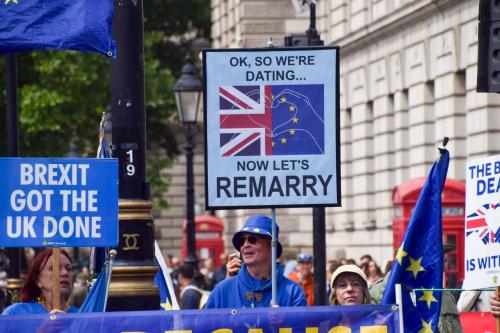This piece is part of a series of policy analyses entitled “The Talbott Papers on Implications of Russia’s Invasion of Ukraine,” named in honor of American statesman and former Brookings Institution President Strobe Talbott. Brookings is grateful to Trustee Phil Knight for his generous support of the Brookings Foreign Policy program.
Executive summary
After gaining independence following the Soviet Union’s 1991 collapse, Ukraine set about building relations with the West, including with institutions such as NATO. In 1994, Ukraine became one of the first states to join the alliance’s Partnership for Peace. Three years later, Ukraine and NATO established a distinctive partnership.
From 2002 to 2008, Kyiv made bids to join NATO or secure a membership action plan, but each time fell short. In 2010, a new Ukrainian president had no interest in drawing his country closer to the alliance. However, government and public interest in NATO began growing in 2014 following the Maidan Revolution, Russia’s illegal seizure of Crimea, and Russia’s instigation of and direct involvement in the fighting in Donbas in eastern Ukraine. The February 2022 large-scale Russian assault locked in President Volodymyr Zelenskyy’s desire to bring Ukraine into NATO.
At their July 2023 summit, NATO leaders expressed support for Ukraine’s ultimate membership, though they did not outline a concrete plan for achieving that, stating they would “extend an invitation to Ukraine to join the Alliance when Allies agree and conditions are met.” That language papered over serious differences, with many allies favoring an invitation to join, to which the United States and Germany were reluctant to agree. On the margins of the summit, G7 leaders committed to support Ukraine with arms and other assistance. That provides a sensible waystation, but a Ukraine that stands alone — even if armed by its Western partners — will prove a temptation for Russian aggression. That would mean less security and stability for Europe.
The United States has long defined a stable and secure Europe as a vital national interest, an objective naturally shared by NATO’s European members. It is increasingly apparent that this will not be possible absent a stable and secure Ukraine. The United States and the West have various options before them. They include the “Israeli model” (arming Ukraine to defend itself), individual security commitments (though apparently short of security guarantees that would entail sending their armed forces to Ukraine’s defense), security commitments by the European Union or another institution, and NATO membership. The first two options would leave Ukraine on its own. The third is difficult to see in the near term. An invitation to Ukraine to join now or at the NATO summit scheduled to take place in Washington in July 2024 seems a bridge too far.
Membership entails the protection of Article 5 of NATO’s founding treaty (“an armed attack against one or more” allies “shall be considered an attack against them all”). Were Ukraine at peace and in NATO, Russia’s consideration of renewing hostilities would face the Kremlin with a tough decision: going to war again against Ukraine would mean war with NATO. Were Ukraine to enter the alliance while still in conflict with Russia, the onus for the decision on going to war would lie with NATO members. They thus far have not been prepared to commit their forces to Ukraine’s defense, which is why some oppose offering an invitation to Kyiv to join. While there have been suggestions to modify Article 5’s application to accommodate Ukraine’s situation, those ideas threaten to dilute Article 5 and weaken the significance of NATO membership.
Accounting for these complexities and the desire to avoid a divisive argument over Ukraine in the run-up to the 2024 Washington summit, the United States and its allies should prepare the ground now so that next July they can announce accession talks with Ukraine. The goal of those talks, conducted in the NATO-Ukraine Council, would be to work toward a formal invitation for Ukraine to join at the earliest possible date. This would put Ukraine on a definitive path to membership, signaling NATO’s commitment to Ukraine to both Kyiv and Moscow. It would also enhance Kyiv’s bargaining position in any future negotiations with Moscow.
-
Acknowledgements and disclosures
The author wishes to thank Daniel Fried, James Goldgeier, John Herbst, Michael McFaul, Michael E. O’Hanlon, Constanze Stelzenmüller, and Alexander Vershbow for their very helpful suggestions to earlier drafts of this paper. Of course, the author remains responsible for its content. The author also thanks Adam Lammon for editing and Rachel Slattery for layout.
The Brookings Institution is committed to quality, independence, and impact.
We are supported by a diverse array of funders. In line with our values and policies, each Brookings publication represents the sole views of its author(s).







